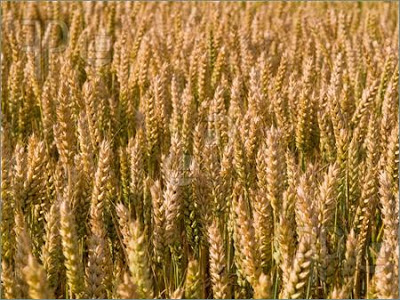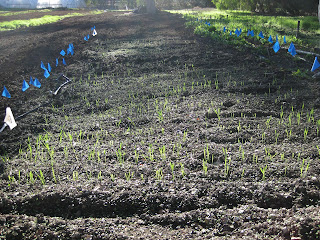If you really want to watch eyes glaze over at your next dinner party, try
describing the stages of growth that our wheat is going through in Agoura
Hills. You might assume that only we small-grain foster parents would want to know all the particular
details. But it is fascinating how this
most important food crop gets from small seeds in the ground, up into a tall
grass, with fruit that eventually provides food for our table.
Basically, we’re talking about germination, plant growth, and final seed
development. But knowing the details and
sub-steps within these major stages gives the grower an opportunity to adjust
fertilizing and irrigation, and better estimate the eventual yield. According to some sources, there are at least
five scales to measure wheat growth, with the one called
Feekes listing eleven stages of growth, and
Zadok dividing the growth
sequence into one hundred steps. Fascinating. How could this not intrigue even the most
jaded guest?
The first surprise is what goes on underground before the first green shoot emerges. The initial (
radicle) roots emerge from the
seed (
caryopsis)
to be followed by a whole different set of (
coronal) roots. A
scholarly
journal describes how these help support winter wheat.
"The anchorage of winter wheat,
Triticum aestivum L., is provided by a cone of rigid coronal roots which emerge from around the
stem base. During root lodging this cone rotates at its windward edge below the
soil surface, the soil inside the cone moving as a block and compressing the
soil beneath. A theoretical model of anchorage suggested that lodging
resistance should be dependent on the diameter of the root-soil cone, coronal
root bending strength and soil shear strength." Those roots are no slouches. Both kinds can grow at nearly an inch a day, and, by the time the wheat is mature, the root system can extend 4’ to 8’
laterally, and downward.
Now, before your dinner guests can change the subject, tell them how wheat begins growing upward. It starts within a stiff protective tube of
greenery, called the
coleoptile.
That will get their attention.
This tube not only protects the tender stem on its way up toward
the soil surface, but it also plays a part in delaying the first leaf until
surface temperatures and conditions are acceptable. Pretty smart plant. The moment when the first leaf emerges from
its tube is Zadok stage 10.
As the stem grows, a series of leaves appear.
At about leaf number four (we’re now at 14 on the Zadok scale),
tillers begin forming. These are side shoots that emerge from the
main stem, put down roots, and grow upward in parallel with the primary stem. A few of them eventually set seed. The whole process of stem elongation then
becomes relatively normal, taking us through Zadok 37. And it is here that the
flag leaf appears. It is the final and uppermost leaf, quite
different from the previous 8 or 9 leaves, because it contains the embryonic
seed head or spike.
 When the head is just a swollen area (making the flag leaf look as
though it is expecting), the plant is entering the boot stage, and our wonderful little grains of wheat are beginning to take
shape. From Zadok 41 to 58, the spike
gradually emerges from its wrapping in the flag leaf, and those individual,
would-be grain kernels begin flowering.
When the head is just a swollen area (making the flag leaf look as
though it is expecting), the plant is entering the boot stage, and our wonderful little grains of wheat are beginning to take
shape. From Zadok 41 to 58, the spike
gradually emerges from its wrapping in the flag leaf, and those individual,
would-be grain kernels begin flowering.
Although the plant has been growing now for several months, the
flowering (
inflorescence)
stage takes only a few days. If you are
beginning to lose your audience, here is another surprising thing about small
grains: the flowers open first at the
center of the head and progress toward the top and the bottom of the
spike. This leads us to pollination (
anthesis), which is when you
can get the attention of those interested in sex. Tell them, discretely, that most wheat is
self-pollinating, and it is a very brief process, with pollination of individual florets completing in less than five minutes. Thus it is quite rare that pollen from another plant enters the picture. The process is completed for the entire crop in less than ten days, empowering a considerable percentage of the little grains along each stalk to begin maturation into tasty wheat
berries (
caryopsis once again),
most of which are identical to the seed we planted.
The final stages of spike growth, Zadok numbers 71 through 100, are
some months away for us in LABB. As described in an
article on the botany of the wheat plant, "the recently fertilized grain is
creamy white in color and when squeezed exudes clear liquid. It grows rapidly, attaining its maximum length in about ten days, and becomes green in
color as chlorophyll is formed. At this stage, the exudate becomes milky as
starch grains are deposited. As growth proceeds, the endosperm becomes firmer
(the soft dough and the hard dough stages) until, at physiological maturity, the
green color is replaced by golden-yellow, which deepens as the grain desiccates
to dead ripeness."
So we
can look forward to seeing the seeds swell, the colors deepen, and the
individual berries be tested -- pressed between thumbnail and forefinger, as
they progress from milk stage to dough stage to hard kernel stage. They gradually firm up until Zadok stages 91 (“hard
to split by thumbnail”), 92 (“cannot split by thumbnail”), and 93 (“kernel
loosening in daytime”).
And we all, including
our dinner guests, will be pleased that harvest time has finally arrived.




















 This is the first of, I hope, a regular series of brief updates on Los Angeles Bread Baker news and events.
This is the first of, I hope, a regular series of brief updates on Los Angeles Bread Baker news and events.









